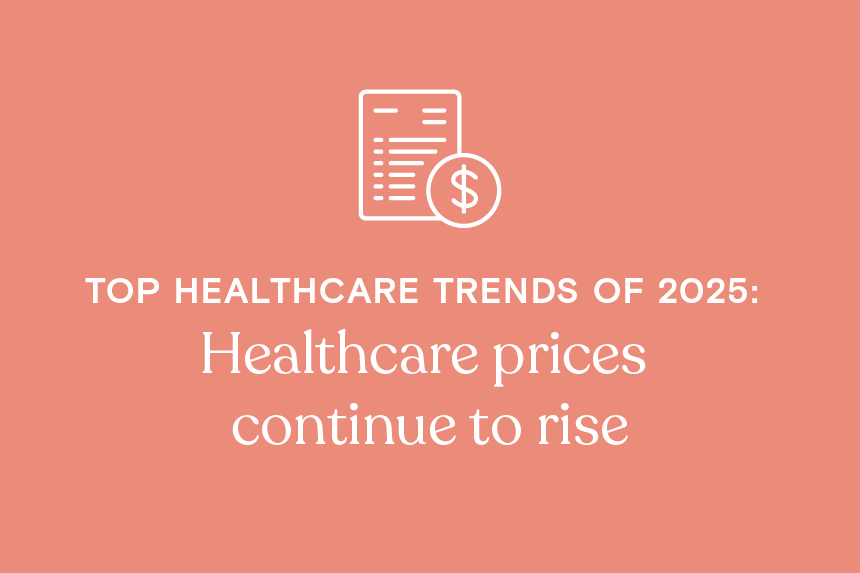As we come to a close on our series of the top healthcare trends of 2025, it’s easy to say that the healthcare industry is in a state of unprecedented transformation.
On the one hand, we are witnessing remarkable advancements in care delivery, technology, and operational efficiencies. However, an escalating financial crisis within the U.S. healthcare landscape is casting a long shadow over these innovations, undermining the system’s ability to provide accessible, affordable, and high-quality care.
In case you missed it, the Centers for Medicare & Medicaid Services (CMS) recently published their report on U.S. national healthcare expenditure (NHE) data—and the outlook is concerning. Individual medical costs are expected to hit their highest level in 13 years by 2025 and, by 2032, NHE are projected to surge by a staggering 70%, reaching an astounding $7.7 trillion.
This alarming trend underscores the urgent need to address the rising cost of healthcare in the United States. In this blog, we’ll explore the underlying factors driving this financial crisis and discuss potential solutions for mitigating its negative consequences.
Reasons why healthcare costs are rising:
- Inflation
- Prescription drug prices
- Decline in employer-sponsored insurance
- Aging population and longer life expectancy
- Chronic disease prevalence
Growing inflation applies pressure on the healthcare industry
Inflation affects healthcare just like any other sector. It increases the price of everything from wages and operational costs to medical equipment and supplies.
The cost growth of medical services usually leads the pack, rising at a faster rate year-over-year than other economic sectors. According to the Peterson Center on Healthcare, medical care prices rose by 3.3% in June 2024. In contrast, the overall prices of all other goods and services in the U.S. grew by 2.9%. This growth is just one part of a greater trend: since 2000, the price of medical care increased by 121% compared to other consumer goods and services, which only rose by 86% over the same period.
Several elements contribute to healthcare inflation, including the U.S.’ aging population and the prevalence of chronic diseases, both of which we’ll discuss in the following sections. Beyond those factors, inefficiencies in healthcare delivery and the supply chain, the trend of mergers, acquisitions, and consolidation in the industry, and high administrative costs also contribute to inflation.
Altogether, the various contributors to healthcare inflation can have a profound and significant impact. It not only affects the affordability and accessibility of healthcare services but also places a significant burden on the budgets of governments, businesses, and individuals alike.
As medical costs surge and inflation grows, we can expect healthcare organizations and leaders will be challenged in 2025 with finding new and innovative ways to manage expenses and find savings.
Three strategies that providers can consider to mitigate the impact of healthcare inflation are:
- Optimizing workforce management: The ongoing healthcare labor shortage is pressuring providers to maximize the time and value of their employees. To manage this, providers can look to automating routine tasks and streamlining administrative responsibilities with AI and other technologies.
- Improving revenue cycle management (RCM) processes: Poor RCM can lead to delays and denials in claims processing, leading to financial losses, penalties, compliance issues, and dissatisfied patients.
- Promote cost transparency: According to a survey by AccessOne, 69% of Gen X patients say transparency is essential. Ensuring that the costs of services are clearly outlined and communicated can help mitigate the risk of patients delaying payment and reduce patient leakage and frustration.
Prescription drug costs must be dealt with
In recent years, the rising cost of prescription drugs has become one of the most pressing issues in the U.S. healthcare system. It’s one of the big-ticket items of the Inflation Reduction Act (which was extended into 2025). It grants Medicare the power to cap out-of-pocket costs, negotiate with drug companies to get lower prices for certain drugs, and penalizes pharmaceutical manufacturers if they raise prices faster than inflation.
The IRA was, in part, a response to the astonishingly high cost of prescription drugs in the U.S. and the financial strain it places on individuals and families. According to one report, overall pharmaceutical expenditures grew by 13.6% in 2023 compared to 2022, for a total of $722.5 billion—more than triple what the U.S. spent in the early 2000s. Without further reform, multiple foundations and the CMS estimate that drug costs will continue to rise throughout the late 2020s and into 2030.
What’s driving this high-cost growth? Multiple factors, including:
- Consolidation: Mergers and acquisitions result in fewer companies making and marketing drugs, which may reduce competition and lead to higher prices.
- Patent protection: By pharmaceutical patent law, other entities are unable to sell generic versions of the drug for the duration of the patent, which lasts for decades, and keeps competition at bay.
- Increased utilization: Demand for prescription drugs have increased as the U.S. population ages, and chronic conditions become more prevalent. Marketing and physician incentives can also contribute to overprescribing.
- High drug prices: Manufacturing drugs is expensive and risky, and often companies set high prices for new medication to recoup R&D costs and maximize profits.
As we look to 2025 and beyond, we may see health insurers, government agencies, and others that pay for prescription drugs employ strategies to slow the growth of medication costs. This could range from expanding the powers granted to Medicare under the Inflation Reduction Act to eliminating marketing tactics that discourage the use of generic drugs or even allowing the purchase of prescription drugs from outside the U.S.
There could also be measures in place to streamline the FDA approval process, which is notorious for being lengthy, expensive, and risky. Expediting the approval process could reduce research and administrative costs and introduce new drugs into the market sooner, which could prevent the use of more expensive treatments. However, the real-world impact of these prospective changes remains to be seen, and for the time being, costs will likely continue to rise without slowing.
Decline in employer-sponsored insurance (ESI)
Employer-sponsored insurance (ESI) is the most common form of health coverage for working Americans, but its share of covered lives is expected to decline in the years to come. By 2032, the CMS expects about 1 in 10 people to be uninsured. This is problematic for several reasons, as people without insurance coverage often have less access to care, receive lower-quality care, and are more likely to delay or forgo care due to costs.
Beyond the rising costs of individual medical services across the healthcare landscape, employer behavior also influences the share of insured people. Should employers strip away benefits or reduce their contribution to ESI plans, it’s the employees who shoulder the burden, often facing higher premiums, deductibles, and copays, which further feeds into the likelihood of postponing or neglecting care.
To compound the problem further, there are few positive choices for people who don’t want ESI or don’t have access to it. Individual insurance plans often have higher premiums and costs (which only increases overall healthcare spending). Alternatively, an influx of people transitioning to Medicaid or ACA marketplaces could place financial pressure on the government. To manage higher expenses, the government could raise taxes or reallocate funding, indirectly driving up costs.
Shifts in the labor market may also explain why fewer people will be insured in the future. With the rise of the gig economy, more Americans are moving into freelance and part-time work, which often does not provide health insurance.
The aging population brings new challenges and changes to healthcare
One of the most significant drivers of rising healthcare expenditures in the U.S. is the growing population of adults aged 65 and older. According to the Population Reference Bureau, older adults account for 17% of the nation’s population. This is expected to grow to 23% by 2050 to a total of 82 million older adults.
This trend presents new challenges in the healthcare ecosystem. As people age, they tend to require more medical and specialized support. For example, older adults are more prone to chronic illnesses such as diabetes, arthritis, heart disease, and dementia. All of these conditions require ongoing medical attention, medication, and hospital visits, significantly driving up national healthcare expenditures.
With more people living longer, there is a greater demand for long-term care services and the professionals and facilities equipped to provide them. Nursing homes, assisted living facilities, and home health aides are costly and labor-intensive, also contributing to rising Medicare costs.
Increased chronic disease prevalence
Healthcare professionals and government agencies have warned for decades that the U.S. has a crisis of chronic disease. It’s so widespread, in fact, that the CDC estimates that 60% of Americans have at least one chronic condition and 40% have two or more.
While chronic conditions are more likely to affect older people, as described above, experts are finding that conditions that used to almost exclusively affect adults now impact younger people at much higher rates. For example, one study reported that stroke rates in patients ages 20-44 increased by 65% between 1993 and 2015.
The COVID-19 pandemic is one of the primary reasons why chronic disease is so prevalent today. Millions of patients skipped appointments, tests, and screenings that were essential for managing chronic illnesses. This led to worsening health in patients and more patients in need of costly care in the ER or hospital.
Chronic diseases are also just naturally more expensive than most other conditions. Patients in need of chronic care management often require frequent visits to their provider or a specialist and need expensive imaging tests and scans, specialty drugs, and ongoing monitoring. The CDC estimates that 90% of all healthcare costs in the U.S. go toward treating chronic disease, about $4.1 trillion a year.
The silver lining is that many chronic diseases are also preventable and avoidable. Conditions like heart disease and diabetes can be linked to lifestyle choices that are within a patient’s own hands to change. Eating healthy, sleeping well, knowing your family history, and exercising regularly can all help lower one’s risk of developing a chronic condition and can help address the symptoms of them. New technologies, as well as promoting health literacy and spreading educational resources about preventing chronic diseases can go a long way in reducing this national crisis.
Learn more
The rising costs of healthcare poses a significant threat to the accessibility, affordability, and quality of care in the U.S. Unfortunately, it’s a multifaceted problem with involves government agencies, businesses, healthcare providers, organizations, and individuals.
It’s not a problem that can be solved overnight, but as we look to how the healthcare landscape might shift in 2025 and beyond, it’s likely that more will need to be done to combat the country’s problem with health expenditures and addressing it will require a collaborative effort.
Looking for more insights on the top healthcare trends you should watch for in 2025? You can start at the beginning of our series with how AI will be a transformative force across healthcare or visit our blog to jump to whichever 2025 healthcare trend interests you most. And to learn more about how our data can help you put your best foot forward next year, start a free trial with Definitive Healthcare today.





